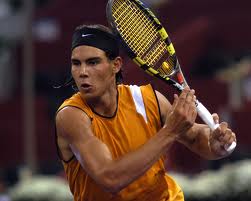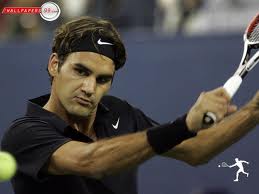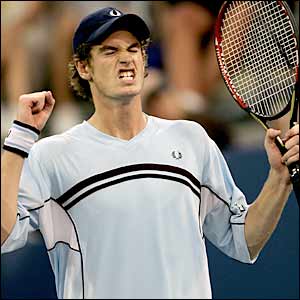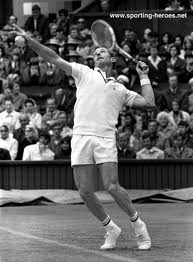More quick metrics following Nadal’s latest domination of the French Open. Our own ratings have Nadal at Number 1 with 7 Frenchies beating a cumulative field twice as good as Borg did in his 6 slams. Nadal has also passed Sampras on the cumulative power list of quality slam victories.
A former pro player mentioned to us that Nadal and Djokovic were beating Federer when he was not at his peak. And, that Federer, as the winner of 16 slams, is just better. This is mind numbingly dumb as 99% of society believes that in any sports endeavor when someone beats someone else, the winner is better than the loser. Nadal’s 6 title wins at Grand Slam finals without a loss to Federer the last 5 years dictates pure superiority. But not for that slim .1% of the tennis intelligentsia and innumerates like Peter Bodo. No wonder other sports fans don’t take tennis seriously. So we have a new metric to cut through the argument.
At #3 in the world, Federer is still at his peak. Since Federer’s first loss to Nadal at the 2006 French Open final when he was 24, Federer has reached the finals of more than 40 atp tournaments or about 47% of his total finals. There has been very little dropoff in performance unlike for example, Lleyton Hewitt, who reached only 9 finals or the last 20% of his career finals after his 2004 loss to Federer at the finals of the US Open and quickly fell out of the ATP top 3. Our eyes don’t deceive us, Federer at his peak is simply not as good as Nadal or Djokovic at their peak.
Below, we have a table that looks at the players Nadal beat in his Grand Slam finals vs. the players Federer and Sampras beat for their championships. Nadal owned Federer 6 times (from Federer at 24 years old to 29, beating him on every surface) and Djokovic twice to win 8 of his 11 championships. Putting a cumulative score on the number of slam wins of Nadal’s opponents, that amount is 106. For Sampras his cumulative score is 48. Federer’s cumulative score is 43 of which 27 come from beating Nadal and Djokovic before they turned 21.5 years old.
Unlike Nadal and Federer, Sampras 3 times beat 3 other grand slam winners to win a slam. His field was much tougher and he didn’t have a 32 seed draw to protect him from early round challengers. Sampras also was winner in 2 of the toughest Wimbledons and US Opens ever played. Nadal won a single slam defeating 3 prior slam winners but never repeated that feat. Federer never accomplished this. Another feat that Sampras accomplished that Federer did not near the end of his career is that when Sampras lost to Marat Safin at the US Open finals in 2000, he came back and defeated him in the subsequent year’s championship. Once Federer has lost to Nadal and Djokovic on any surface at a Slam, he has never beaten them again at that Slam.
But just who did Federer beat at his slam championships. Close scrutiny shows he won against a collections of journeymen named Andy (Palookas), Nadal and Djokovic before their prime (Puppies) and the Ghost of Andre Agassi. Four of Federer’s slam victories, and 4 of his cumulative “points” came against Andy Roddick. Andy Roddick never should have won the 2003 US Open. He was losing to David Nalbandian 2 sets to love, in a 3rd set tiebreaker with the score 7-7 when a fan called an in ball “Out” and Nalbandian mishit the next ball and lost the next point, the next two sets and the match. Another 2 of Federer’s slams came against Andy Murray. So 6 of his 16 have come against …
Palookas Named Andy
All Federer’s Slam wins against Nadal and Djokovic came before their peaks. Federer won his first slam at 21 and 11 months old.
Federer’s other big win was against an over the hill, 35 year old Agassi. Agassi was a shell of the player that demolished Federer at the US Open in 2002 when he was 32 years old. Taking out Federer’s win over out of his prime Agassi in 2005 with before their prime Nadal and Djokovic (as our former pro would do), his overall slam score falls to a mundane 8 points with wins over Palookas like Andy Murray, Marcos Baghdatis and Robin Soderling.
In contrast Sampras beat a host of players at their peak such as Edberg, Becker, Lendl, Agassi, Courier and Chang. He was the best player on hard courts until his last tournament, the 2002 US Open, which he won. The year following Sampras’ loss to Marat Safin at the US Open finals, he came back and beat him at the next year’s semifinals. Similarly, Nadal also came back in 2010 to avenge his loss against Soderling at Roland Garros. Federer hasn’t won a Wimbledon, his best surface, since 2009 and that year Nadal was out with a knee injury. It has been 5 years since Federer won a Wimbledon with Nadal in the field. If Nadal isn’t injured or out at the end of 2008 through the beginning of 2010, maybe Federer’s slam count stays at 14 and Nadal’s is at 13.
You can say for the all time greatest, Federer had a very short peak, from 21 years and 11 months old to 25 and 11 months old (the last time he beat Nadal at a slam) unlike any other all time great. Or that his path to number 1 was paved with Palookas named Andy.










